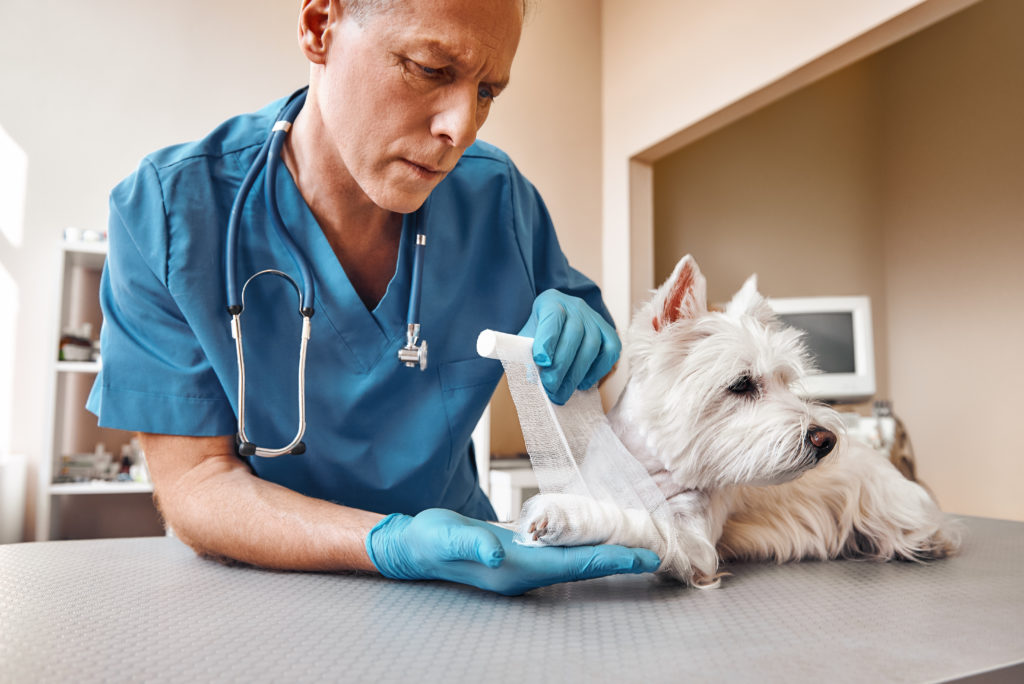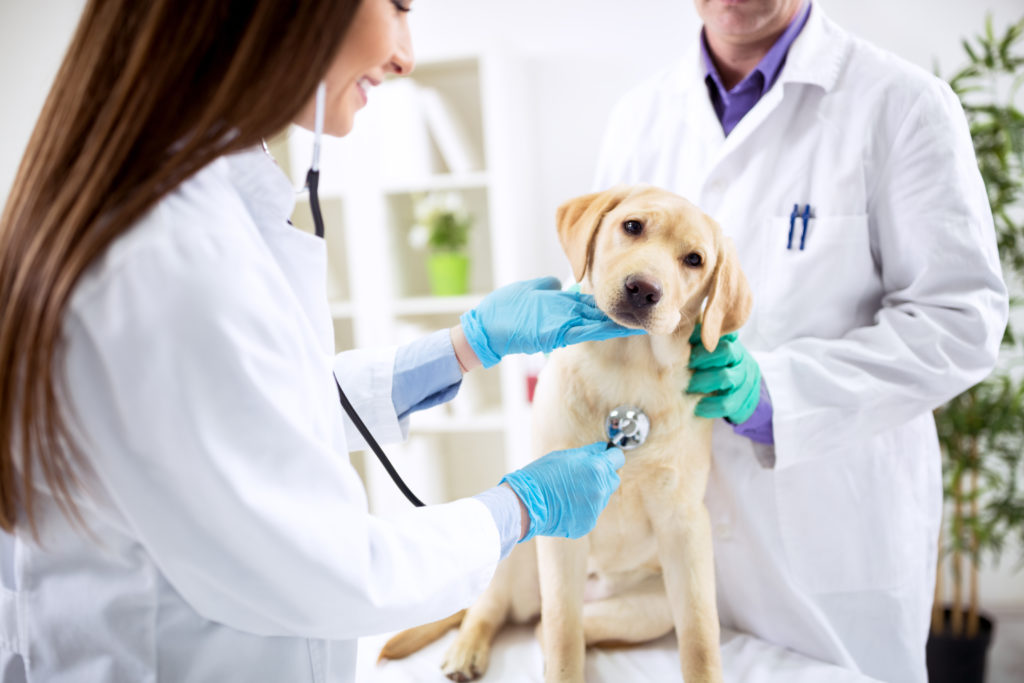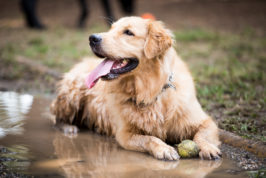Adding a new puppy to your family is a wonderful – but stressful – experience. Puppies bring fun and excitement to your life, but they are also a huge responsibility. It’s normal to worry about feeding them the right food, training them correctly, and giving them the right amount of exercise, and then there’s puppy-proofing the house! So, what if, despite your best efforts to care for your puppy and keep them safe, they get hurt? Well, here is a guide to some common puppy injuries.
Common puppy injuries
Puppies often have lots of energy and can be mischievous. Even with undivided care and attention, accidents can happen. Although you can monitor minor injuries at home, if your puppy is very lethargic, is bleeding, or has difficulty breathing, it’s essential to seek veterinary advice immediately.
Puppy leg injuries

It is pretty common for puppies to get leg injuries, either from jumps or falls or from crush injuries from being accidentally stepped on or shut in a door. So, what symptoms would you expect to see if your puppy has a leg injury?
Symptoms of puppy leg injuries
If your puppy sustains an injury to their leg, you might notice signs straight away. However, sometimes the symptoms can worsen over time or even appear later. The most important symptoms to look out for are limping, swelling, pain, bleeding, or visible wounds.
If there is damage to the bone, then your puppy will likely have some swelling, as well as being unwilling to put weight on the leg. If they are unable or unwilling to weight bear on one of their legs then this is a veterinary emergency, and you should make an appointment with your veterinarian straight away. On the other hand, if your pup has a bit of a limp but can still weight-bear, the bone is unlikely to be fractured.
Paw injuries in puppies
Puppies can make silly decisions like chasing bees or wasps or getting under their humans’ feet because they haven’t got much life experience yet! Puppy paw injuries can vary from bites or stings to fractured toes, burns, or splinters. If your puppy has a paw injury, you might notice them limping or holding their paw up. You might also see them licking at their foot or that the paw is hot or swollen.
In cases where glass, thorns, or other foreign objects have penetrated the paw, you might notice a wound. However, sometimes the entry wound can close quite quickly, so don’t be fooled if you don’t see one! Although any potential splinter or foot-foreign-body should be seen by a vet promptly (ideally within twenty-four hours), if there is a large wound or significant blood loss your puppy should visit the veterinarian as an emergency.
Shoulder and hip injuries in puppies

Thankfully, the most common shoulder and hip injuries in puppies are soft tissue injuries where the bone and joint are not damaged. These can be caused by over-exertion, landing awkwardly from a jump or fall, or running into things. Soft tissue injuries tend to respond well to rest and anti-inflammatory medication, but always consult your vet for advice in case the injury is more serious.
More severe shoulder injuries include fractures involving the joint itself and dislocations. If your puppy has a severe injury to the shoulder or hip joint, they won’t be able to bear weight on the affected leg, and you should take them to the veterinarian right away. Surgery is often required to prevent mobility issues and pain in the future.
Growth plate injuries in puppies
One type of injury that puppies get but adult dogs don’t are growth plate injuries. These occur when there is severe damage to a bone in the area of the growth plate. Growth plates are areas of bone where growth occurs, and when your puppy reaches its adult size, their growth plates will close. While the growth plates are active, they are a weak point in the bone, leaving the bone susceptible to injury.
An example of this is the Tibial Crest Avulsion, where the tendon of the knee pulls a portion of the tibia bone off via a fracture through the growth plate. These cases require surgery to re-attach the bone portion. Whenever a growth plate sustains damage, it can lead to early closure of that portion of the growth plate. This can lead to abnormal or asymmetrical bone growth and can cause long-term issues like arthritis, chronic pain, and limping.
The risk of injury to the growth plate in puppies is one of the reasons it’s so important to get a young dog checked by a veterinarian if they sustain an injury to their leg. There is no way of knowing without an x-ray whether the growth plate is affected or not, and the long-term implications of a growth plate injury are serious.
My puppy has a leg injury – what should I do?
If your puppy is limping or has wounds or swelling, it’s always best to get them checked over by a veterinarian. Not only are they likely to be in pain, but they may also require treatment to prevent future issues. If necessary, the vet will recommend taking x-rays to check for a fracture or foreign material before medication or surgical treatment can be provided.
Head injuries in puppies

With puppies being so inquisitive, they naturally accidentally find themselves in the way sometimes. Mostly, as pet parents, we notice them lingering opportunistically by the door before we close it. We even find ourselves craning over the pile of laundry in our arms to check that they are not underfoot. After all, that’s life with a puppy!
But sometimes the worst happens, and puppies can be accidentally kicked, squashed, or shut in a door – it’s easily done if you’re in a hurry and not paying enough attention. It’s common for these types of incidents to cause your puppy a head injury.
Signs of a head injury range from being depressed and lethargic to having seizures or vomiting. It is vital to get your pup an urgent appointment with a veterinarian if you think they have sustained any head injury.
What should I do in an emergency?
If you think your puppy has a severe or life-threatening injury, contact a veterinarian straight away.
If you have someone with you, ask them to contact the vet while you care for your puppy. Although it’s not easy, it’s important to stay calm and not panic. If they are losing a lot of blood, try applying pressure with a clean dressing or tea towel.
Try to keep them warm by wrapping them in a blanket or coat, and when you handle them, be aware that they are likely to be in pain. Once you have made contact with your vet, they will advise you of anything else you can do to help during your journey to the clinic.
So, how serious are puppy injuries?
Puppies are great fun, but they are not always the most sensible. This means they are more prone to injury, and because they are small, fragile, and still growing, these injuries can sometimes have life-long implications. Always ensure your home is puppy-proofed and take care when moving around the house in case they are nearby.
Ultimately, though, accidents happen, and not all injuries can be prevented. The most important thing is to get any puppy injuries checked by a veterinarian as soon as possible to make sure they live a long and healthy life.
Searching for more puppy guides? Find out how long you should walk your puppy for or how to manage separation anxiety.





I really like how you elaborated on how dogs are susceptible to leg and head injuries by getting stuck on a door. My friend talked about how she’s interested in adopting a puppy after watching a dog movie. I should let her know that there are wound care products that can help her puppy during these situations.